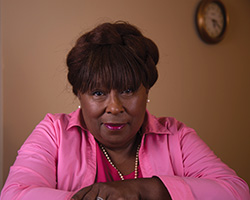 Diane Faison
Diane FaisonDiane Faison, clothed in mid-19th century garb, wanders through the audience, breaking the hushed silence with “I am the spirit of Harriet Tubman.”
Her audience begins to enter another world… the 19th century world of the underground railroad leader, her childhood in slavery, her dream of freedom, and finally, her life as humanitarian/Union spy.
 Diane Faison as Harriet Tubman
Diane Faison as Harriet TubmanDiane Faison found inspiration for her performance almost 30 years ago when she searched for a way to make history real for her middle school students during Black History month. Scanning the shelves in the library’s biography section, she picked up a book that had fallen off the shelf. “As I bent down, I heard a voice say, ‘Tell my story,’” she says. The book was a biography of Harriet Tubman. From that moment Diane was inspired. “I dressed as Harriet Tubman would have dressed and I’ve been telling her story ever since.”
Diane began to research the black woman, born in another century, who led hundreds of slaves to freedom, then returned to the south as a Union spy. Many of Tubman’s own words are integrated into the script, keeping true to her spirit as much as possible.
A Winston-Salem native, Diana lives in Gibsonville. She tours North Carolina and neighboring states, performing at retirement homes, schools, civic organizations, and universities.
Following her performance, members of the audience ask questions about Harriet Tubman, her life, and her legacy.
A Wells Fargo Arts in Education grant through the Winston-Salem Arts Council enabled her to introduce Harriet Tubman in public schools throughout Forsyth County. Other grants have supported performances in black churches and retirement homes with high Medicaid populations. She recently received a regional artist grant from the Alamance Arts Council to perform in local schools free of charge.
Her website is: https://spiritofharriettub.wixsite.com/spiritofharriet/about-us.
Introducing Harriet Tubman
Harriet Tubman was undoubtedly the most famous conductor of the Underground Railroad, a lifeline for slaves escaping to freedom in the mid 19th century.
She was born a slave and raised on Maryland’s Eastern Shore where it was not unusual for families in the area to own both the free and enslaved. Her husband, John Tubman, was a free black man, but her status was unchanged until she fled to Pennsylvania, a free state, in 1849. She returned to Maryland many times over the next decade to rescue both family and non-family members from the bondage of slavery.
Harriet was an active proponent of women’s suffrage and worked alongside women such as Susan B. Anthony. During the civil war, she also worked for the Union Army as a cook, a nurse, and Union spy.
In 2016, the U.S. Treasury Department announced that the countenance of Harriet Tubman will appear on a new $20 bill.

